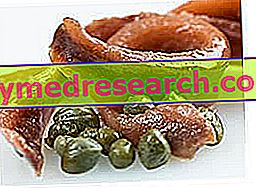The liver is a very important glandular organ, which is entrusted with numerous body functions.
Among the various, it is responsible for the metabolism of nutrients (amino acids, glucides, lipids), the storage of vitamins and the transformation of all pharmacologically active molecules (drugs, caffeine, alcohol, etc.).

We talk about fatty liver (hepatic steatosis) when the organ increases in size until it goes beyond + 5% of normal volume.
The causes of fatty liver are due to: genetic disorders, metabolic pathologies, malnutrition and dietary factors, alcohol addiction, anemia, drugs, etc.
It appears more frequently in people aged 50-60 and in pregnant women.
Fatty liver is often asymptomatic or causes local discomfort in the right quadrant of the abdomen (not to be confused with gallbladder discomfort).
If neglected it can worsen in more serious disorders.
What to do
In the doubt of being affected by hepatic steatosis it is necessary:
- Go to the doctor to make an assessment. The diagnosis includes:
- Palpation: often the fatted liver is frankly swollen and perceptible.
- Ultrasound: the change in the cellular composition of the hepatocytes is very visible, but must be of considerable magnitude.
- Blood analysis: in addition to detecting possible causes of steatosis (eg hyperglycemia), it identifies the presence of liver enzymes poured into the stream after the breakdown of inflamed hepatocytes (especially transaminases and alkaline phosphatase).
- Biopsy: it is a very invasive analysis and normally is not part of the diagnostic pathway for hepatic steatosis.
- If the diagnosis is positive, stop the steatotic process and prevent evolution in steatohepatitis (and, at worst, into cirrhosis).
- Exclude alcoholic beverages.
- In case of overweight (especially in the visceral area), lose weight.
- Treat any metabolic pathologies such as:
- Metabolic syndrome.
- Insulin resistance, hyperglycemia and type 2 diabetes mellitus.
- Hypertriglyceridemia.
- Hypercholesterolemia.
- Respect a proper diet (see below); in particular it is necessary to monitor:
- Amount of calories.
- Vitamin levels.
- Distribution of energy nutrients.
- Breakdown of meals.
- If the subject lives in 3rd or 4th world conditions, treat Kwashiorkor.
- Prevent or cure severe anemia.
- Limit the intake of toxic molecules, drugs, pharmacologically active molecules, contaminants and pollutants.
- If present, treat hormonal imbalances of: cortisol, ACTH, T3, T4 and catecholamines.
What NOT to do
- Neglecting the symptoms of a possible hepatic steatosis.
- Do not perform specific diagnostic investigations.
- Consume a lot of alcohol.
- Grease or stay overweight.
- Adopt a sedentary lifestyle without motor activity.
- Neglecting any metabolic pathologies: metabolic syndrome, insulin resistance, hyperglycemia and type 2 diabetes mellitus, hypertriglyceridemia and hypercholesterolemia.
- Follow an incorrect and unbalanced diet.
- If the subject lives in 3rd or 4th world conditions, do not consider the malnutrition syndrome called Kwashiorkior.
- Neglecting severe anemia.
- Expose yourself excessively or increase your intake of:
- Drugs: cortisone, tetracycline, anabolic steroids.
- Nervini: caffeine, theophylline etc.
- Certain food additives.
- Contaminants and pollutants: for example carbon tetrachloride.
- Ignore hormonal imbalances.
What to eat
To learn more: Diet for Fatty Liver
The fatty liver diet may be slightly different depending on the nutritional status of the subject:
- In the case of obesity or overweight with an evident visceral deposit, the diet should be low-calorie slimming. We recommend a reduction in total calories of -30%.
- Nutrient breakdown is similar to the traditional Mediterranean diet, with greater importance than complex carbohydrates compared to simple ones and unsaturated fats (especially polyunsaturated fats) compared to saturated fats.
- The breakdown of meals is quite traditional: breakfast 15% of total calories, 2 snacks at 5%, lunch at 40% and dinner at 35%. It is possible to emphasize snacks to decrease the caloric intake of lunch and dinner.
- Since hepatic steatosis worsens with increasing index and glycemic load, carbohydrate sources will need to be:
- Low glycemic index: vegetables, little or medium sweet fruit, legumes and whole grains.
- In moderate portions: it is recommended not to exceed 150g of fruit at a time and 60-70g of cereals for first courses, legumes or bread at a time.
- Foods rich in fiber: especially soluble ones that are able to modulate intestinal absorption.
- Foods rich in good fats: they exert a positive effect on lipemia and improve the metabolic condition; in particular:
- Omega 3: are eicosapentaenoic acid (EPA), docosahexaenoic (DHA) and alpha linolenic acid (ALA). They play a protective role towards all the diseases of the part and have an anti-inflammatory role. The first two are biologically very active and are contained above all in: Sardinian, mackerel, bonito, alaccia, herring, alletterato, ventresca of tuna, needlefish, algae, krill etc .. The third, instead, is less active but constitutes a precursor of EPA; it is mainly contained in the fat fraction of certain foods of vegetable origin or in the oils of: soy, linseed, kiwi seeds, grape seeds, etc.
- Foods rich in antioxidants:
- Vitaminics: the antioxidant vitamins are carotenoids (provitamin A), vitamin C and vitamin E. They have a beneficial effect on all metabolic parameters, as they hinder oxidative stress.
Carotenoids are contained in vegetables and red or orange fruits (apricots, peppers, melons, peaches, carrots, squash, tomatoes, etc.); they are also present in shellfish and milk.
Vitamin C is typical of sour fruit and some vegetables (lemons, oranges, mandarins, grapefruit, kiwi, peppers, parsley, chicory, lettuce, tomatoes, cabbage, etc.).
Vitamin E is available in the lipid portion of many seeds and related oils (wheat germ, maize germ, sesame, etc.).
- Minerals: zinc and selenium. The first is mainly contained in: liver, meat, milk and derivatives, some bivalve molluscs (especially oysters). The second is contained above all in: meat, fishery products, egg yolk, milk and dairy products, fortified foods (potatoes, etc.).
- Polyphenols: simple phenols, flavonoids, tannins. Some fall within the group of phytosterols (isoflavones). They behave more or less like vitamins. Lower oxidative stress and optimize lipoprotein metabolism; appear to correlate with a reduction in total cholesterol and LDL. They are very rich in polyphenols: vegetables (onion, garlic, citrus fruits, cherries, etc.), fruit and their seeds (pomegranate, grapes, berries, etc.), wine, oilseeds, coffee, tea, cocoa, legumes and whole grains, etc.
- Foods rich in purifying and reconstituting substances for the liver: they are mainly the cynarin and the silymarin contained in the artichoke and milk thistle.
- In the case of protein malnutrition (third and fourth world, anorexia nervosa, severe alcoholism, etc.), improve the biological value of proteins and guarantee their minimum daily intake.
- In the case of generalized vitamin malnutrition (third and fourth worlds, anorexia nervosa, severe alcoholism, etc.), increase ESPECIALLY the intake of vitamin B12 (contained exclusively in foods of animal origin), biotin (like the previous one) and pantothenic acid (especially in the legumes and in the liver).
- In case of severe anemia, increase the intake of:
- Haem iron: mainly found in meat, offal and fishery products.
- Cobalamin: vit B12 is typical of foods of animal origin.
- Folic acid: it is characteristic of raw vegetable foods (lettuce, apples, oranges, etc.).
What NOT to Eat
- High-calorie and binge foods.
- Above all, avoid junk foods, fast foods, pastry foods, etc.
- Alcohol.
- Foods and beverages rich in nerves: caffeine, theophylline, theobromine. They are contained in coffee, cola, energy drinks, tonics such as guarana, etc.
- Foods and beverages rich in carbohydrates, especially refined and / or simple, with a high glycemic index and in significant quantities. Sugary drinks, desserts, sweet snacks, refined flours etc.
- Foods rich in saturated or hydrogenated fats and cholesterol: fatty cheeses, sweet and savory snacks, margarines, hamburgers, frankfurters, cuts of fatty meat (pancetta, coppone etc.), sausages (sausage, salami, etc.), cured meats (lard, rolled bacon) ) etc.
- Foods rich in additives: mainly packaged foods.
Natural Cures and Remedies
Certain supplements and herbal remedies are useful for fatty liver:
- Metabolism supplements:
- Silymarin and cynarin: purifiers and regenerating for the liver.
- Glutathione.
- Phosphatidylcholine.
- Polyphenols and other antioxidants.
- Lecithins and phytosterols.
- Absorption modulating integrators:
- Sequestering fats: chitosan, lecithins, etc.
- Carbohydrates sequestering: acarbose.
- Fibers: psyllium seeds, guar gum, glucomannan, guggul etc.
- Herbal remedies (for decoction, infusion, drug in capsules or tablets etc.):
- Gentian.
- Artichoke.
- Milk thistle.
- Propolis.
- Rosemary sprouts.
- Fenugreek.
- Garlic.
- Licorice.
- Gymnema.
Pharmacological care
Very often the pharmacological treatment of fatty liver consists of remedies aimed at the remission of primary diseases:
- Antidiabetics:
- Pioglitazone: for example Actos and Glubrava.
- Rosiglitazone: for example Avandia.
- Antiobesity drugs:
- Orlistat: for example Xenical and Alli.
- Nutraceuticals:
- Betaine: for example Cystadane.
- Drugs for alcohol abuse:
- Metadoxine: for example Metadoxil.
Prevention
The prevention of fatty liver and long-term complications includes:
- Limit or eliminate alcohol.
- Practicing physical activity.
- Avoid overweight or lose weight (especially in the case of android and visceral obesity).
- Contain / cure metabolic diseases.
- Especially hyperglycemia (or type 2 diabetes mellitus), hypertriglyceridemia and hypercholesterolemia.
- Avoid overeating.
- Avoid extreme fasts.
- Prevent anemia.
- Limit the pharmacological intake and especially of the products that predispose to steatosis.
- Limit the intake of nerves and additives.
- Do not expose the body to toxic substances.
- To compensate for certain hormonal imbalances.
Medical Treatments
There are no medical treatments for fatty liver other than pharmacological.
On the other hand, a remission of steatosis proportional to weight loss is observed in the obese. This is why some bariatric surgical procedures are considered decisive, such as:
- Intragastric balloon.
- Gastric bandage.
- Gastric bypass.



